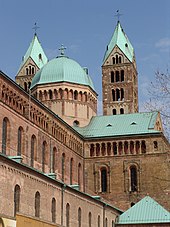Sex prelude
The Sexpräbendare (from Middle Latin sex "six" and praebendarius "maintenance recipient "), also six-partner , were a group of usually six priests at the Speyer Cathedral .
history
The office of sex praisees occurs at the Speyer Cathedral from around the 12th to the 18th century.
Since the noble canons only required the ordination as subdeacon to enter the cathedral chapter and many of them often did not receive a higher ordination later on, a shortage of priests gradually arose who could hold the daily services in the cathedral. At that time this was a general problem of cathedral and collegiate chapters.
At the Speyer Cathedral they helped themselves over this grievance with the office of sex prebendars or six-partnerers.
Originally there were a total of 40 benefices here for the cathedral capitals . Six of them were removed and given to six non-aristocratic priests (hence the name Sexpräbendar / Sechspfründner). They had to attend the choir prayer and to celebrate the daily masses together with those canons who had received the priestly ordination . However, the sex prebendaries did not belong to the cathedral chapter and had no right to vote in the chapter meetings. They were only representatives of the capitulars in the spiritual functions for which the ordination was necessary.
Festive high offices were often levitated , i.e. H. two other clerics, with the rank of deacon and sub-deacon, called Levites , supported the celebrating priest to elevate the festivities. Therefore, a clerical group was required on public holidays, which at least had to be ordained as a deacon. Two more canons' foundations were therefore taken, halved and given to four non-aristocratic clerics. In Speyer , these were called semiprabendars , and they had to act as Levites at the high offices in the cathedral .
The office of sex priest can also be proven at the Wimpfen knight monastery in the diocese of Worms .
The parish of St. Dionysius in Brühl Moss has a 1591 dated chalice with donor engraving of Beatus Moses , vicar general of the diocese of Speyer , where he is called "Sexpräbendar in Speyer". A famous sex priest was Rutger Edinger (* around 1545) from Cologne , benefactor of the Franciscan monastery in Speyer , who made a name for himself as a liturgist and early translator of psalms and mass texts.
literature
- Konrad von Busch , Franz Xaver Glasschröder : Choir Rule and Younger Sea Book of the old Speier Cathedral Chapter Volume 2, p. XIII, Historisches Museum der Pfalz, Speyer 1926
- Franz Schorn: Johann Hugo von Orsbeck: a Rhenish church prince of the baroque period , Wienand Verlag, 1976, ISBN 3879090653 , p. 76; (Detail scan)
Web links
- Document relating to a sex priest, 1459
- Document relating to a sex priest, 1596
- Document regarding a sex praise dare, 1622 in the German Digital Library
Individual evidence
- ↑ Christoph Fuchs: Dives, pauper, nobilis, magister, frater, clericus: Social historical studies on Heidelberg university visitors of the late Middle Ages (1386–1450) , 1995, p. 272, ISBN 9004101470 ; (Digital scan)
- ^ Journal for the history of the Upper Rhine , Volume 11, p. 174, footnote 99, Karlsruhe, 1860; (Digital scan)
- ↑ Website for the chalice of Beatus Moses
- ^ Robert Haaß : Edinger (Edingius), Rutger. In: New German Biography (NDB). Volume 4, Duncker & Humblot, Berlin 1959, ISBN 3-428-00185-0 , p. 314 ( digitized version ).
- ^ Journal for the history of the Upper Rhine , Volume 6, 1891, p. 690 and 691; (Detail scan)

